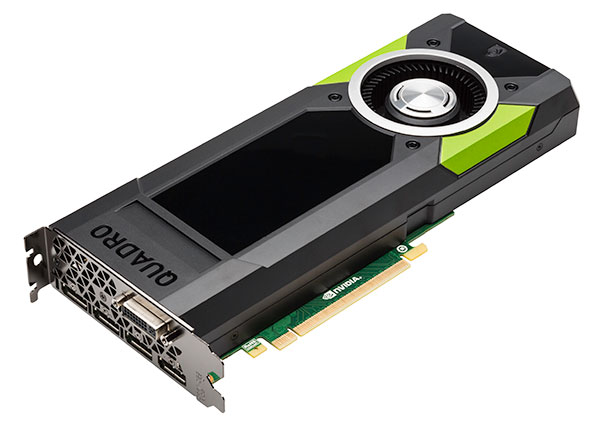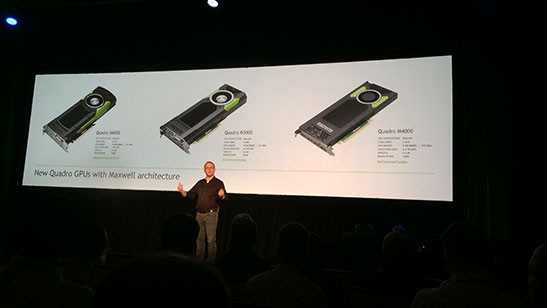New Software Tools, Libraries and Technologies Advance Physically Based Rendering Technology
Almost as an afterthought, Nvidia announced two new Quadro video cards at SIGGRAPH yesterday.
Both new cards are based on Nvidia's Maxwell GPU architecture. The Quadro M5000 [pictured, below] has 2,048 Cuda cores, boasts 8 GB of GDDR5 GPU memory running at up to 211 GB/sec, and can run four 4K displays, Nvidia said. The somewhat less powerful Quadro M4000 has a mere 1,664 Cuda cores, and 8 GB of GDDR5 memory at up to 192 GB/sec. It can also push pixels on four 4K displays.

But the real story from Nvidia had to do with design. New advances in CG technology are "changing the way design is done," Nvidia's VP of Enterprise Marketing Greg Estes said, setting a tone for the company's announcements.
The remark kicked off a presentation by Steven Parker [pictured, top], the company's VP of engineering and CTO of advanced rendering, that illustrated how Nvidia's technology is being deployed across multiple markets, including architecture, product design, and the emerging field of VR applications.
Parker announced Nvidia DesignWorks, a new set of libraries, algortithms and other tools that aims to let application developers work more efficiently with phsyically based rendering and physically based materials. Included in DesignWorks are Nvidia's Iray SDK; its Material Definition Language, or MDL; its vMaterials library of "a few hundred" calibrated and verified materials for use in MDL-based applications; its OptiX framework for ray-tracing applications, and the DesignWorks VR set of tools for virtual reality workflow.
The lion's share of time was dedicated to the visualization work done by Gensler, the architecture and design firm that is building Nvidia's new 500,000-square-foot headquarters across from its current offices in Santa Clara, CA. The building is tricky to visualize in CG because of its ample skylighting properties that allow natural light to flow through the building and reflect off walls. New advances in visual computing, Nvidia said, allow the building's designers to show off a rendered version of the building interactively, changing the outside view and moving the camera around inside the space at will, with the details of exceptionally accurate renders filling in more quickly than ever before.
Harley-Davidson was on stage, too, showing how a new Iray plug-in for Rhino design software allows it to do elaborate and accurate visualizations directly inside Rhino. Harley was a beta-tester of Allegorithmic's latest version of Substance Designer, which is taking advantage of Nvidia DesignWorks by way of Iray integration using the new SDK. Substance Designer is also integrating Adobe Illustrator support, allowing graphic elements to incorporated in renders viewed inside Rhino. Substance Designer v5.2 will be released in September, the company said.
Finally, Parker offered a look at DesignWorks VR, with multi-resolution shading (so that the part of a VR render that is nearest the center of your field of vision gets additional horsepower thrown at it), VR SLI (so that the left eye and the right eye can have their own individual GPUs for speeding performance), and a new warp and blend API to manage complex projections of immersive footage.
More information on DesignWorks is available at Nvidia's website.
Did you enjoy this article? Sign up to receive the StudioDaily Fix eletter containing the latest stories, including news, videos, interviews, reviews and more.











Leave a Reply